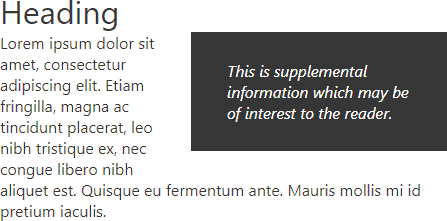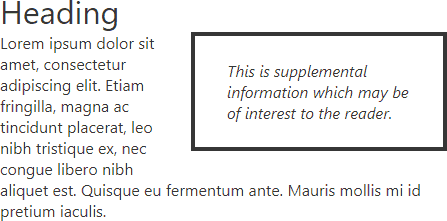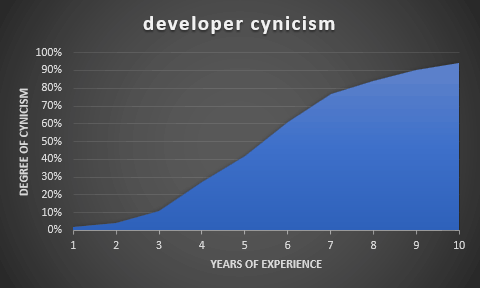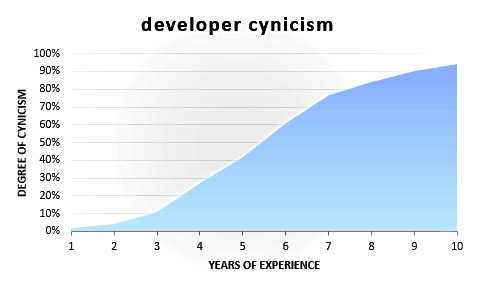- How to Create Printer-friendly Pages with CSS
- Print Style Sheets
- Testing Printer Output
- Print Preview
- Developer Tools
- Hack Your Media Attribute
- Remove Unnecessary Sections
- Linearize the Layout
- Printer Styling
- Adopt CSS Columns
- Use Borders Instead of Background Colors
- Remove or Invert Images
- Add Supplementary Content
- Page Breaks
- Printing Pains
- Share This Article
How to Create Printer-friendly Pages with CSS
“Who prints web pages?” I hear you cry! Relatively few pages will ever be reproduced on paper. But consider:
- printing travel or concert tickets
- reproducing route directions or timetables
- saving a copy for offline reading
- accessing information in an area with poor connectivity
- using data in dangerous or dirty conditions — for example, a kitchen or factory
- outputting draft content for written annotations
- printing web receipts for bookkeeping purposes
- providing documents to those with disabilities who find it difficult to use a screen
- printing a page for your colleague who refuses to use this newfangled t’internet nonsense.
Unfortunately, printing pages can be a frustrating experience:
- text can be too small, too large, or too faint
- columns can be too narrow, too wide, or overflow page margins
- sections may be cropped or disappear entirely
- ink is wasted on unnecessary colored backgrounds and images
- link URLs can’t be seen
- icons, menus, and advertisements are printed which could never be clicked!
Many developers advocate web accessibility, yet few remember to make the printed web accessible!
Converting responsive, continuous media to paged paper of any size and orientation can be challenging. However, CSS print control has been possible for many years, and a basic style sheet can be completed within hours. The following sections describe well-supported and practical options for making your pages printer-friendly.
Print Style Sheets
- Applied in addition to screen styling. Taking your screen styles as a base, the printer styles override those defaults as necessary.
- Applied as separate styles. The screen and print styles are entirely separate; both start from the browser’s default styles.
The choice will depend on your site/app. Personally, I use screen styles as a print base most of the time. However, I have used separate style sheets for applications with radically different outputs — such as a conference session booking system which displayed a timetable grid on-screen but a chronological schedule on paper.
A print style sheet can be added to the HTML after the standard style sheet:
link rel="stylesheet" href="main.css" /> link rel="stylesheet" media="print" href="print.css" /> The print.css styles will be applied in addition to screen styles when the page is printed.
To separate screen and print media, main.css should target the screen only:
link rel="stylesheet" media="screen" href="main.css" /> link rel="stylesheet" media="print" href="print.css" /> Alternatively, print styles can be included within an existing CSS file using @media rules. For example:
/* main.css */ body margin: 2em; color: #fff; background-color: #000; > /* override styles when printing */ @media print body margin: 0; color: #000; background-color: #fff; > > Any number of @media print rules can be added, so this may be practical for keeping associated styles together. Screen and print rules can also be separated if necessary:
/* main.css */ /* on-screen styles */ @media screen body margin: 2em; color: #fff; background-color: #000; > > /* print styles */ @media print body margin: 0; color: #000; background-color: #fff; > > Testing Printer Output
It’s not necessary to kill trees and use outrageously expensive ink every time you want to test your print layout! The following options replicate print styles on-screen.
Print Preview
The most reliable option is the print preview option in your browser. This shows how page breaks will be handled using your default paper size.
Alternatively, you may be able to save or preview the page by exporting to a PDF.
Developer Tools
The DevTools ( F12 or Cmd/Ctrl + Shift + I ) can emulate print styles, although page breaks won’t be shown.
In Chrome, open the Developer Tools and select More Tools, then Rendering from the three-dot icon menu at the top right. Change the Emulate CSS Media to print at the bottom of that panel.
In Firefox, open the Developer Tools and click the Toggle print media simulation icon on the Inspector tab’s style pane:
Hack Your Media Attribute
Presuming you’re using a tag to load printer CSS, you could temporarily change the media attribute to screen :
link rel="stylesheet" href="main.css" /> link rel="stylesheet" media="screen" href="print.css" /> Again, this won’t reveal page breaks. Don’t forget to restore the attribute to media=»print» once you finish testing.
Remove Unnecessary Sections
Before doing anything else, remove and collapse redundant content with display: none; . Typical unnecessary sections on paper could include navigation menus, hero images, headers, footers, forms, sidebars, social media widgets, and advertising blocks (usually anything in an iframe ):
/* print.css */ header, footer, aside, nav, form, iframe, .menu, .hero, .adslot display: none; > It may be necessary to use display: none !important; if CSS or JavaScript functionality is showing elements according to particular UI states. Using !important isn’t normally recommended, but we can justify its use in a basic set of printer styles which override screen defaults.
Linearize the Layout
It pains me to say this, but Flexbox and Grid rarely play nicely with printer layouts in any browser. If you encounter issues, consider using display: block; or similar on layout boxes and adjust dimensions as necessary. For example, set width: 100%; to span the full page width.
Printer Styling
Printer-friendly styling can now be applied. Recommendations:
- ensure you use dark text on a white background
- consider using a serif font, which may be easier to read
- adjust the text size to 12pt or higher
- modify paddings and margins where necessary. Standard cm , mm , or in units may be more practical.
Further suggestions include …
Adopt CSS Columns
Standard A4 and US Letter paper can result in longer and less readable lines of text. Consider using CSS columns in print layouts. For example:
/* print.css */ article column-width: 17em; column-gap: 3em; > In this example, columns will be created when there’s at least 37em of horizontal space. There’s no need to set media queries; additional columns will be added on wider paper.
Use Borders Instead of Background Colors
Your template may have sections or call-out boxes denoted by darker or inverse color schemes:
Save ink by representing those elements with a border:
Remove or Invert Images
Users will not want to print decorative and non-essential images and backgrounds. You could consider a default where all images are hidden unless they have a print class:
/* print.css */ * background-image: none !important; > img, svg display: none !important; > img.print, svg.print display: block; max-width: 100%; > Ideally, printed images should use dark colors on a light background. It may be possible to change HTML-embedded SVG colors in CSS, but there will be situations where you have darker bitmaps:
A CSS filter can be used to invert and adjust colors in the print style sheet. For example:
/* print.css */ img.dark filter: invert(100%) hue-rotate(180deg) brightness(120%) contrast(150%); > Add Supplementary Content
Printed media often requires additional information which would not be necessary on-screen. The CSS content property can be employed to append text to ::before and ::after pseudo-elements. For example, display a link’s URL in brackets after the text:
/* print.css */ a::after content: " (" attr(href) ")"; > Or you can add print-only messages:
/* print.css */ main::after content: "Copyright site.com"; display: block; text-align: center; > For more complex situations, consider using a class such as print on elements which should only be visible when printed,. For example:
p class="print">Article printed at 1:23pm 5 September 2020. Please see https://site.com/page for the latest version.p> /* hidden on-screen */ .print display: none; > @media print /* visible when printed */ .print display: block; > > Note: most browsers display the URL and current date/time on the printed page’s header and/or footer, so there’s rarely a need to generate this information in code.
Page Breaks
The CSS3 properties break-before and break-after allow you control how page, column, or region breaks behave before and after an element. Support is excellent, but older browsers may use the similar page-break-before and page-break-after properties.
The following break-before and break-after values can be used:
- auto : the default — a break is permitted but not forced
- avoid : avoid a break on the page, column or region
- avoid-page : avoid a page break
- page : force a page break
- always : an alias of page
- left : force page breaks so the next is a left page
- right : force page breaks so the next is a right page
Example: force a page break immediately prior to any heading:
/* print.css */ h1 break-before: always; > Note: be wary of over-using page breaks. Ideally, printer output should use as few pages as possible.
The break-inside (and older page-break-inside ) property specifies whether a page break is permitted inside an element. The commonly supported values:
- auto : the default — a break is permitted but not forced
- avoid : avoid an inner break where possible
- avoid-page : avoid an inner page break where possible
This can be preferable to specifying page breaks, since you can use as little paper as possible while avoiding page breaks within grouped data such as tables or images:
/* print.css */ table, img, svg break-inside: avoid; > The widows property specifies the minimum number of lines in a block that must be shown at the top of a page. Imagine a block with five lines of text. The browser wants to make a page break after line four so the last line appears at the top of the next page. Setting widows: 3; breaks on or before line two so at least three lines carry over to the next page.
The orphans property is similar to widows except it controls the minimum number of lines to show at the bottom of a page.
The box-decoration-break property controls element borders across pages. When an element with a border has an inner page break:
- slice : the default, splits the layout. The top border is shown on the first page and the bottom border is shown on the second page.
- clone : replicates the margin, padding, and border. All four borders are shown on both pages.
Finally, CSS Paged Media ( @page ) has limited browser support but provides a way to target specific pages so alternative margins or breaks can be defined:
/* print.css */ /* target all pages */ @page margin: 2cm; > /* target the first page only */ @page :first margin-top: 6cm; > /* target left (even-numbered) pages only */ @page :left margin-right: 4cm; > /* target right (odd-numbered) pages only */ @page :right margin-left: 4cm; > The CSS page break properties can be placed within your screen or print styles because they only affect printing, but I recommend using them in print CSS for clarity.
Be aware that page break control is little more than a suggestion to the browser. There’s no guarantee a break will be forced or avoided because layout is restricted to the confines of the paper.
Printing Pains
Control over printing web media will always be limited, and results can vary across browsers. That said:
- printer-friendly style sheets can be retro-fitted to any site
- most printer styling will work in the majority of browsers
- print styles will not affect or break existing functionality
- the development costs are minimal.
Adding a few page breaks and removing unnecessary sections will delight users and raise your site above competitors. Add it to your to-do list!
For more advanced CSS knowledge, read our book, CSS Master, 2nd Edition.
Share This Article
Craig is a freelance UK web consultant who built his first page for IE2.0 in 1995. Since that time he’s been advocating standards, accessibility, and best-practice HTML5 techniques. He’s created enterprise specifications, websites and online applications for companies and organisations including the UK Parliament, the European Parliament, the Department of Energy & Climate Change, Microsoft, and more. He’s written more than 1,000 articles for SitePoint and you can find him @craigbuckler.




